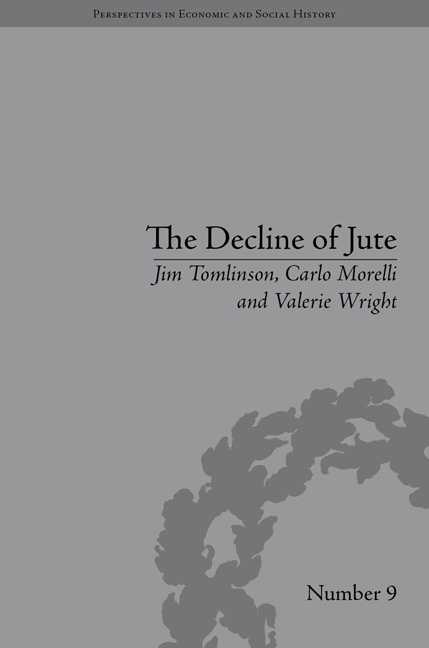Book contents
- Frontmatter
- CONTENTS
- Dedication
- Acknowledgements
- Abbreviations
- List of Figures and Tables
- Introduction
- 1 The Story up to 1939
- 2 De-Globalization and Decline, 1939–99
- 3 The Industry and its Workforce
- 4 Defending the Domestic Industry
- 5 Firms’ Responses to the Decline of the Industry
- 6 Influencing Government
- 7 The Decline of Jute and the Economic Health of Dundee
- Conclusions
- Notes
- Works Cited
- Index
Introduction
- Frontmatter
- CONTENTS
- Dedication
- Acknowledgements
- Abbreviations
- List of Figures and Tables
- Introduction
- 1 The Story up to 1939
- 2 De-Globalization and Decline, 1939–99
- 3 The Industry and its Workforce
- 4 Defending the Domestic Industry
- 5 Firms’ Responses to the Decline of the Industry
- 6 Influencing Government
- 7 The Decline of Jute and the Economic Health of Dundee
- Conclusions
- Notes
- Works Cited
- Index
Summary
A central feature of British history in the twentieth century is the long decline of the great staple export industries of the pre-1914 period. These industries were the core of Britain's industrial economy before the First World War, employing huge numbers, and providing the majority of exports which underpinned Britain's extraordinarily globalized economy of that era. At the time of the 1907 Census of Production the four biggest of these staples – textiles, coal, iron and steel and general engineering – employed 25 per cent of the working population and produced 50 per cent of net industrial output. Coal, textiles and iron and steel alone contributed over 70 per cent of total British export earnings. But over the following decades, at varying tempos, they all shrank to a small fraction of their previous size. After the great iron and steel and coal strikes of the 1980s these two industries followed cotton and shipbuilding downwards, with employment in iron and steel going from 186,000 in 1979 to 54,000 by 1990, in coal over the same period from 232,000 to 42, 000. The contribution of these four to British trade had likewise shrunk to insignificance.
The demise of these industries resulted in both their owners and governments facing enormous problems of ‘managing decline’. On the employers side a whole range of responses were deployed, usually in combination.
- Type
- Chapter
- Information
- The Decline of JuteManaging Industrial Change, pp. 1 - 8Publisher: Pickering & ChattoFirst published in: 2014



